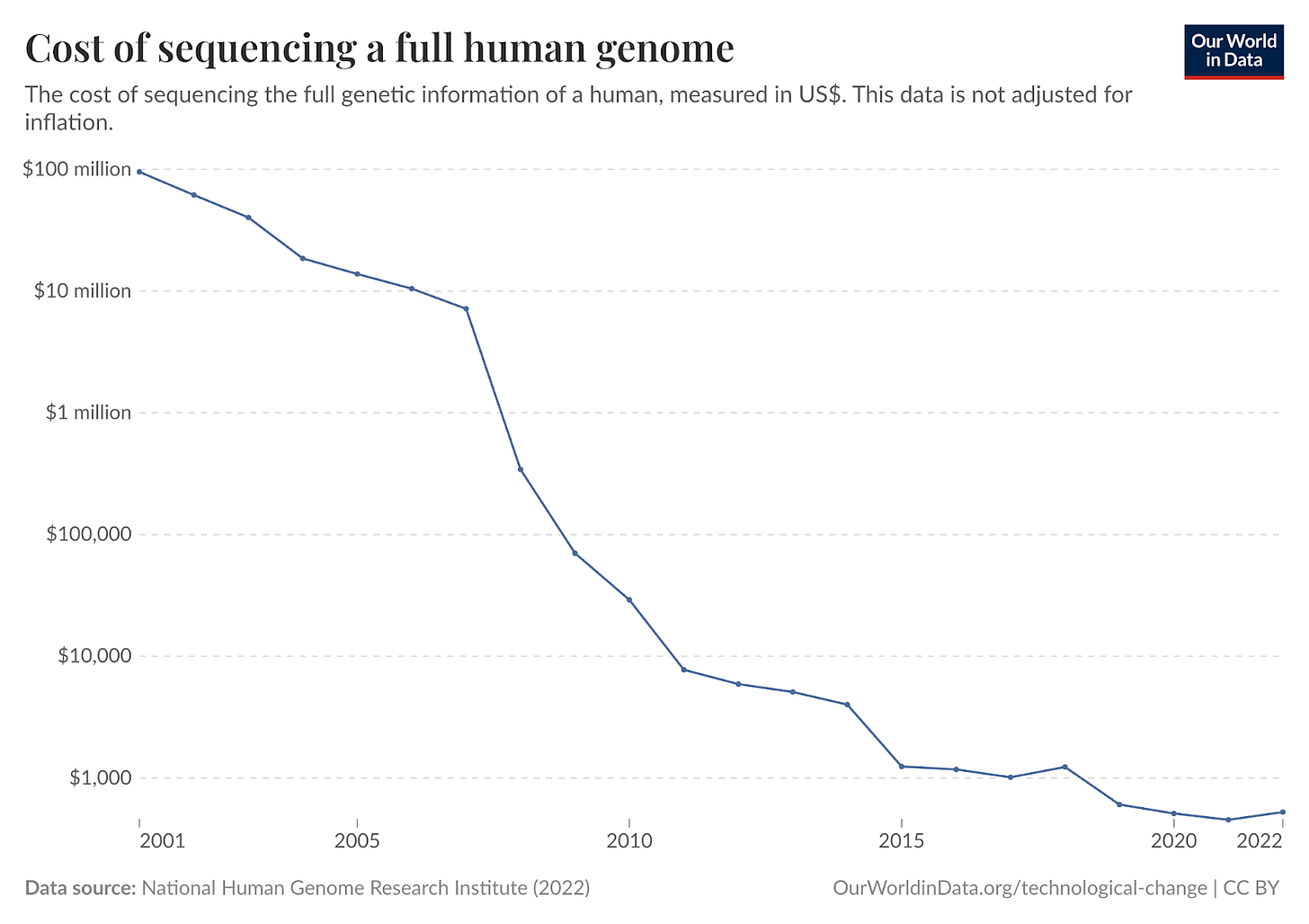We recently released Issue 18 of Works in Progress. Read about prehistoric psychopaths, fertility on demand and the king of fruits here. Today on Links in Progress Asimov Press’s Niko McCarty and our own Saloni Dattani return to review more important things happening in the world of biotechnology and medicine.
1. Nanopore sequencing is a promising, low-cost alternative to traditional genome sequencing methods. Nanopores are tiny holes in a membrane. When a molecule passes through a nanopore, it disrupts an electric field. Fluctuations in the field can be ‘decoded’ to figure out whether a passing molecule was an adenine, thymine, or something else. Unfortunately, its use has been limited by poor spatial resolution. Roche has developed a new sequencing method called Sequencing by Expansion (SBX), which expands DNA molecules into larger polymer structures called Xpandomers and makes them easier to read with nanopores. If successful, SBX would improve the accuracy of nanopore sequencing and bring costs down.
2. Justin Sandefur and Charles Kenny estimate that US foreign aid prevents around 3 million deaths per year at a cost of only 0.2 percent of the US’s GNI. The Trump administration has scrapped 90 percent of all USAID contracts, including some of the most impactful programs. The scrapped contracts seem to include all tuberculosis programs, programs supplying essential medicines for maternal and child health; programs providing HIV treatment; UNICEF’s polio vaccination program; contracts for disease outbreak prevention, detection, and response; emergency food aid; earthquake assistance and more.
3. The FDA approved a non-opioid painkiller. Journavx, developed by Vertex Pharmaceuticals, targets a protein called the NaV1.8 voltage-gated sodium channel, which transmits pain signals from sensory neurons to the brain. No other drugs on the market target this protein; existing painkillers instead bind to several other different NaV channels at once. In a phase 3 trial with 2,000 patients undergoing surgery, Journavx reduced pain as effectively as hydrocodone plus paracetamol and had fewer side effects. It also does not appear to be addictive. But the drug will cost about $233 per week; opioids cost about $12 per week.
4. The FDA approved a new vaccine for chikungunya, a mosquito-borne disease that can result in joint pain for months. The new vaccine was developed by Bavarian Nordic, the same company that manufactured the Jynneos Mpox vaccine. Bavarian Nordic have been rewarded for the results of their chikungunya vaccine with a ‘priority disease voucher,’ which will allow them the opportunity to jump the FDA review queue with another drug. Because they primarily affect poorer countries, drugs for curing tropical diseases face a limited financial market. The ‘priority disease voucher’ acts as a reward for Bavarian Nordic, who can use it to get their next drug to market faster.
5. A guide to ‘forensic metascience’. James Heathers, a researcher and scientific sleuth, has published a textbook explaining how to probe academic studies for potential errors, questionable research practices, and scientific fraud.
6. Chinese researchers made mice with two genetic fathers. They took sperm from male mice and reprogrammed them into stem cells, effectively ‘rewinding’ their development. Those stem cells retained only one set of chromosomes, like normal sperm, but were then fused with a second sperm’s DNA — resulting in both XX and XY sex chromosomes. The resulting DNA was injected into an egg without a nucleus, producing embryos with two paternal genomes. Out of 164 attempts, seven mouse pups were born; they survived to adulthood but had serious health problems and were infertile.
7. Arc Institute launched the largest AI model yet for biology. Called Evo 2, it was trained on 9.3 trillion nucleotides of DNA from 128,000 organisms. Evo 2 can predict whether a given mutation in a DNA sequence will be pathogenic with over 90 percent accuracy, even in instances where scientists have not previously studied that mutation in the laboratory. The model was trained on 2,000 NVIDIA H100 GPUs – about 150 times more compute than AlphaFold. Asimov Press covered the story.
8. In 2022, the retraction rate across hundreds of journals slightly exceeded 0.2 percent, but about 80 percent of these retractions came from journals owned by a single publisher: Hindawi. This latest Nature report shows that the problem is pervasive for specific publishers and for select universities. Jining First People’s Hospital had a five percent retraction rate between 2014 and 2024, which is 50-times the global average. In 2023, 60 percent of retractions were from Chinese institutions.
9. Enzymes speed up chemical reactions. They often do so by going through multiple steps to complete a reaction cycle. However, designing new multi-step enzymes has been challenging because AI tools typically predict static protein structures rather than capturing their dynamic movements. To overcome this, scientists combined AI models RFDiffusion and AlphaFold2, as well as a custom tool called PLACER, to create a “multi-step enzyme” for the first time. Though these AI-designed enzymes are much slower than natural ones (10-3–10-1 vs. 102–105 reactions per second), this proof of concept opens the door to engineering entirely new enzymes that do not exist in nature.





